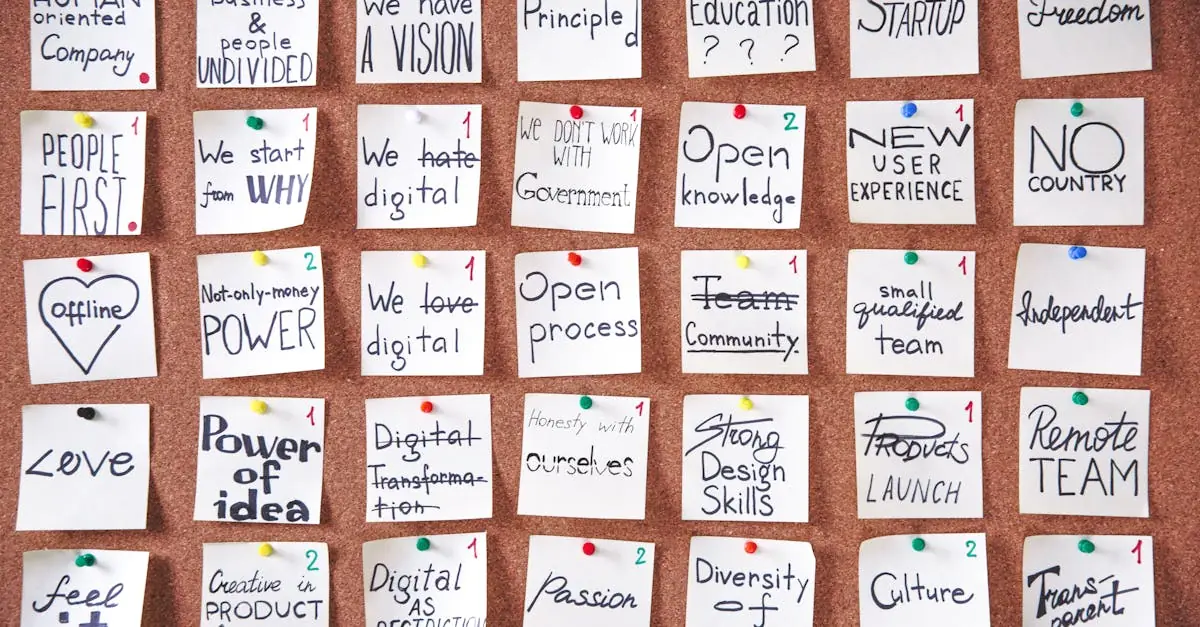Table of Contents
ToggleDesign isn’t just about making things pretty; it’s about creating experiences that resonate. Whether it’s a sleek website that guides users effortlessly or a cozy café that invites customers to linger, design concepts shape our interactions with the world. But let’s face it, sometimes even the best designers need a little inspiration to spark their creativity.
From minimalist marvels to bold, eclectic styles, design concepts can transform the mundane into the extraordinary. This article dives into a treasure trove of examples that showcase the magic of design. Get ready to explore innovative ideas that not only catch the eye but also tell a story. So grab a cup of coffee, sit back, and prepare to be inspired by the design world’s finest creations.
Overview of Design Concepts
Design concepts encompass various ideas and themes that guide the creative process. They serve as foundational elements, shaping the overall aesthetic and functionality of a project. Examples of these concepts include minimalist design, which emphasizes simplicity and the elimination of unnecessary elements. Bold styles, on the other hand, focus on strong colors and dramatic visuals, creating a striking impact.
Color theory plays a significant role in design concepts. Designers use color to evoke specific emotions, create visual hierarchies, and enhance brand identity. Understanding the psychology of colors can greatly influence the effectiveness of any design.
Another key concept involves spatial design, which addresses the arrangement and flow of physical or digital spaces. Effective spatial design ensures that layouts facilitate user navigation and enhance experiences. This concept is crucial in interior architecture and web design, where user experience is paramount.
Typography stands as a vital design concept as well. Selecting appropriate fonts and styles impacts readability and visual appeal. Designers must consider typography alongside other elements to maintain consistency and reinforce messaging.
Functionality remains a core focus in all design concepts. Without addressing the needs and expectations of users, even the most visually stunning designs may fail. Balancing aesthetics with usability creates effective solutions that resonate with audiences.
Exploring various design concepts provides a roadmap for innovation. By integrating diverse approaches and ideas, designers can create immersive experiences that captivate users. The journey through design concepts illustrates how creativity can transform ordinary spaces into extraordinary environments.
Types of Design Concepts
Design concepts encompass various categories that guide creativity in shaping experiences. They range from visual aesthetics to user interactions, each playing a vital role in effective design.
Visual Design Concepts
Visual design concepts focus on the aesthetics of a project. They include elements like color, layout, and imagery. Color theory dictates how hues evoke emotions and impact perceptions. Layout design emphasizes balance and alignment to enhance visual flow. Typography choices influence readability and the overall message. Strong visual elements create memorable impressions, enhancing user engagement.
Interaction Design Concepts
Interaction design concepts prioritize how users engage with a product. These concepts ensure intuitive navigation and responsive elements. User feedback plays a crucial role in shaping interactions, with buttons and links guiding users through experiences. Additionally, these designs consider usability and accessibility, making it easier for diverse audiences to interact. Thoughtful interaction design creates smooth transitions, keeping users engaged and satisfied.
User Experience Design Concepts
User experience design concepts concentrate on the overall journey users take with a product. They address usability and functionality, ensuring designs meet user needs effectively. Research and testing inform choices that enhance satisfaction. Emotional responses drive effective user experience; fostering connections between the user and the product becomes essential. These concepts guide designers in creating products that resonate with users on multiple levels.
Notable Design Concepts Examples
Various design concepts enhance creativity and functionality. Each concept serves a unique purpose, showcasing innovative solutions across disciplines.
Case Study: Minimalism in Design
Minimalism embodies simplicity and essentialism. Designers remove unnecessary elements to create clean, uncluttered spaces. IKEA exemplifies minimalism with its sleek furniture that maximizes space and functionality. The focus remains on practical design while ensuring aesthetic appeal. This approach enables users to engage with their environments, experiencing calmness amidst simplicity.
Case Study: Biomimicry in Design
Biomimicry draws inspiration from nature’s solutions. Designers study organisms to solve human challenges, leading to innovative applications. The Eden Project in the UK illustrates biomimicry, as its geodesic domes mimic natural ecosystems. This design promotes sustainable practices and energy efficiency. By replicating nature, designers cultivate harmony between functionality and environmental stewardship.
Case Study: Sustainable Design Practices
Sustainable design prioritizes environmental responsibility. Designers aim for eco-friendly materials and processes, significantly reducing carbon footprints. The Bullitt Center in Seattle, known as the greenest commercial building, showcases sustainable design principles with its rainwater collection system and solar panels. Emphasizing sustainability fosters resilience and promotes a healthier planet. Through these examples, sustainable design influences future projects, melding innovation with environmental ethics.
Importance of Design Concepts
Design concepts play a crucial role in defining the quality and effectiveness of any project. They provide a framework that guides the creative process, ensuring that every detail serves a purpose. Effective design influences user experience significantly, impacting how users perceive and interact with a product or space.
Functional design concepts enhance usability, making navigation intuitive and stress-free. They prioritize user needs, confirming that aesthetics alone cannot achieve success. Instead, the synergy between form and function drives engagement and satisfaction.
Moreover, visual design concepts capture attention through compelling aesthetics. Color choices evoke specific emotions, while typography enhances readability and clarity. Engaging layouts make information digestible, enhancing user experience.
Interaction design concepts create pathways for seamless engagement. They consider user behavior and expectations, allowing for responsive elements that adapt to various devices. Prioritizing accessibility ensures that designs cater to all users, supporting broader community inclusion.
Sustainable design has emerged as a vital consideration, responding to environmental concerns. It emphasizes energy-efficient practices and eco-friendly materials, significantly reducing carbon footprints. Projects like the Bullitt Center demonstrate how sustainability can meet functionality and aesthetic appeal.
By exploring various design concepts, designers unlock innovative solutions that can transform ordinary environments. The right combination elevates a space from mundane to extraordinary. Each concept contributes uniquely, weaving together a cohesive narrative that shapes user experiences and interactions.
Design concepts play a crucial role in shaping experiences that resonate with users. By understanding and applying various styles and principles, designers can create environments that are not only visually appealing but also functional and engaging. The exploration of minimalist approaches and bold aesthetics demonstrates how diverse strategies can elevate everyday interactions.
As sustainability continues to gain importance, integrating eco-friendly practices into design becomes essential. The examples highlighted in the article serve as inspiration for those looking to enhance their projects. Ultimately, embracing these concepts empowers designers to craft meaningful experiences that leave a lasting impact.




